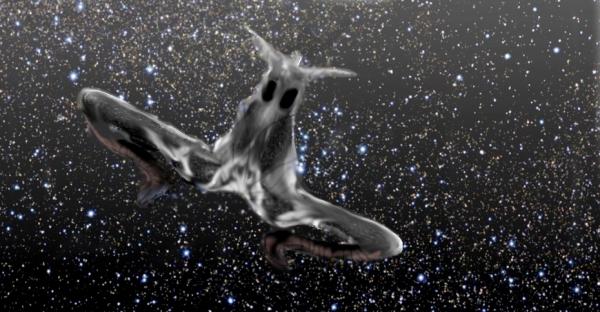BY LETTER
Disposal of the Dead
Burial methods in the Terragen Sphere | |
 Image from Steve Bowers | |
| Sco BH-76, Threshold - a black hole used for burial practices | |
Most modosophonts in the Terragen Sphere have extended lifespans, and can live thousands of years if they want to, depending on whether the society they live in can accommodate that wish. But even the most long-lived modo eventually either ascends/transcends, uploads to a virch or dies, either by accident (or murder in the less civilized polities) or suicide. When this happens, it is quite usual for the biological body to be disposed of in some fashion; the disposal practices vary considerably from polity to polity, and from clade to clade. Some practices resemble burial practices that once were commonplace on Old Earth or other early colony worlds, while others derive from more recent traditions.
Most, but not all such disposal practices are accompanied by a ceremony of some kind, from solemn religious or secular ceremonies to wild feasts and celebrations. Some societies simply dispose of their dead bodies without fuss, especially among clades which have little or no human heritage.
Common methods include a wide range of inhumation, burial in a range of positions and orientations, cremation, sea burial and sky burial (burial on elevated platforms for birds or other aerial lifeforms to consume). Exposure on the bare ground allows surface organisms to perform the same function.
In a generation ship or a relatively resources-poor habitat the body would normally be recycled. Some cultures which were colonised by generation ships, or which have passed through a condition where resources were scarce in the past still continue this practice, even when recycling is not a necessity.
Another form of undertaking is the space burial, a practice which is strictly controlled (in almost all systems any space debris is carefully monitored, and a body will be tracked in perpetuity unless it intercepts a planet).
In many systems the body may be accelerated to the local escape velocity and shot into interstellar space. Starship burial is also quite common, where the body is ejected from a ship at cruising speed. It is likely that the single example of Dead Drifter, Species HIE091MZE found in interstellar space was the subject of an interstellar burial approximately 190 million years ago by an otherwise unknown culture. Note that most starship burials occur at much greater than galactic escape velocity, so the remains will leave the Milky Way in due course unless they encounter an obstacle.
Preservation by various methods is also practiced, mummification, taxidermy and conversion to diamondoid are all options. The Living Tableau is an unusual custom, practiced in New Earth and several other locations, the body is animated using robotics and will act out scenes from eir life history, or sometimes various fictional scenarios.
In the Nathan system a brief fashion for re-using the bodies of the dead as robotic slaves (zomborgs) was quickly suppressed by the local authorities, although in the current era some sophonts in this system and elsewhere will their bodies to be used in this fashion after their death, or as robotic prey to be hunted by carnivores (usually provolved ones).
Releasing a body above a terrestrial planet to burn up on re-entry is another common method; if this is carried out correctly nothing substantial will reach the ground.
Burial into an ordinary star, a white dwarf or neutron star, a brown dwarf or gas giant is also an option. In these cases there is a chance that some of the atoms of the body could be gathered at some future date by sun miners or cloud harvesters.
 Image from Steve Bowers | |
| The sole example of HIE091MZE, an otherwise unknown species, found floating in space in Sagittarius near the coreward Periphery | |
The body may be released into a black hole, such as Threshold, a popular burial location; in this case the atoms will be lost forever. Because of relativistic effects, as seen by an outside observer the deceased will never reach the event horizon; in theory they could be retrieved, but this becomes essentially impossible a short while after the body is dropped. Some groups, especially in the Negentropy Alliance, consider this to be wasteful. However most consider that the losses are insignificant; a human body has only a 100 sextillionth (10^23) as much mass as an Earth-like planet.
The major limitation of black hole burial is the distance and transport costs involved; most systems are more than three hundred light years from the nearest stellar-mass black hole.
Related Articles
Appears in Topics
Development Notes
Text by Steve Bowers
Victor Daniel, Mark Ryherd
Initially published on 03 September 2013.
Victor Daniel, Mark Ryherd
Initially published on 03 September 2013.






